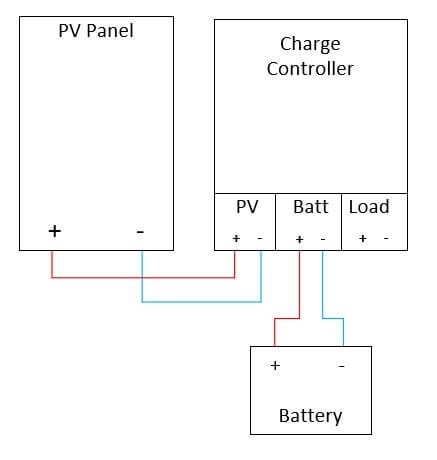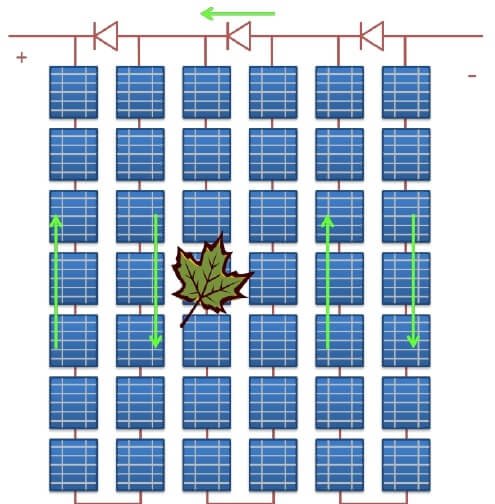Before answering the question:
Do Solar Panels Need Blocking or Bypass Diodes?
let’s do a quick revision. Solar panels consist of solar cells that convert sunlight into electricity through the photovoltaic effect. Mainly, we use two kinds of diodes for effective solar panels – bypass and blocking diodes.
You may be wondering, what is the difference? Well, not much. The blocking diodes are connected in series, while the bypass diodes have a parallel connection.

In theory, these two diodes are physically identical. However, they perform differently because of their setup location and connection.
Now, let’s have a detailed look at blocking diodes and bypass diodes, and if you really need blocking diodes for your solar panels. I will walk you through the whole process, starting from the basics. Let’s dive in!
Do You Need Blocking Diodes for Your Solar Panels?
To understand the working mechanism behind blocking diodes, we will consider a simple example. Let’s suppose you need to charge a battery using two solar panels. For that, you will also need a charge controller, depending on the type of battery you have. Don’t forget that connecting a battery directly to the solar panels can overcharge and damage your battery.

Working Mechanism
We will first see what happens in the daytime. When the sun is out, your solar panels will have some voltage because of the photovoltaic effect. If the voltage of the two solar panels combined is greater than your battery’s voltage, it will get charged.
On the other hand, with no sunlight at night, the solar panels can’t produce voltage. The battery’s voltage, however, is not dependent on sunlight. With no panels’ voltage to overcome the battery’s voltage, there comes a situation when the battery starts to discharge.
What Happens Next?
What happens is, the battery’s voltage triggers the current to flow in the reverse direction through the solar panels. Recall that a diode allows current to flow in one direction only. It may seem like we are stuck, but there is a way out.
Remember we talked about the charge controller earlier? They mostly come with built-in blocking diodes to prevent the current from flowing backward into the solar panels at night. In simple words, your battery won’t discharge because of the blocking diode in the charge controller.
Blocking Diodes in Solar Panel Arrays
Since you have a basic understanding of the blocking diodes, let’s move on to the solar panel arrays that are much more complicated. In the above example, you only had to deal with a single solar panel. In real life, this is mostly not the case. You may come across multiple strings as well.
A solar panel array has more than one branch or strings connected in parallel, consisting of solar panels, bypass diodes, and blocking diodes. You will find out about bypass diodes in detail below this heading.
Here, you will see that a blocking diode has an additional function. It doesn’t allow the current produced by the strong parallel solar panel string to flow in reverse through the shaded or weaker string.
Besides that, a blocking diode allows the flow of electrical current to reach the external body, which could be a controller or a battery.
Not only that, but there is another important benefit of using blocking diodes. They protect the battery in case of a short circuit.
Next question: How can they do that?
If there is a short circuit in one of the branches, the blocking diode will stop the neighboring solar panel strings to drain through the short-circuited string.
Importance of Bypass Diodes in Solar panels
As mentioned earlier, the diode used in blocking and bypass diodes is mostly the same. However, they are used differently according to the purpose. Let’s figure out how bypass diodes work with solar panels.
Working Mechanism
Imagine that one of the solar panels in the above example is not getting a good amount of sunlight as compared to the first one. It may be because of a tree branch, dust particles, or even snow.
What do you think will happen now? The shaded panel will produce less current, thus less power. This isn’t something you are looking for, right? If you are connecting panels in series, you will have reduced power output. Therefore, if you expect shade on your panels, you need to use parallel connections instead.
You have to make sure that the unshaded panel avoids the route of the shaded panel at all costs because high resistance will stop the significant power flow. Lucky for you, there is a solution which will be already built-in into most solar panels.
Let’s get straight to the solution. This is where bypass diodes make a difference. If you connect these diodes in parallel with the solar panels, they will allow the current from the unshaded panel to flow into them. Other than that, bypass diodes also make sure that the current flowing from unshaded panels doesn’t end up overheating and igniting the shaded panels.
In the following image, you can see one solar panel with 42 (6×7) individual solar cells. If one cell is covered by a leaf, the second string of solar cells will not produce any current. If there were no bypass diodes, the whole solar panel would produce none or very little current. Thanks to the bypass diodes, the solar panels will still produce 2/3 of it’s rated current.
In my book, I explain why shading has an influence on the current and not on voltage.

Key Factors to Remember
I’m hoping that up till now, you have enough knowledge about the working of blocking and bypass diodes. Moving on, there are some key points you should take care of while working with solar panels.
Another important thing is to protect these diodes. For safety purposes, you shouldn’t experiment with the installation of blocking and bypass diodes. It is better to consult a trained professional in this regard. However, most of the solar panel array already has a built-in bypass and blocking diodes. Nevertheless, you still have to be careful.
Let’s Rewind
I hope this article helped you in learning about blocking diodes and how they are necessary for solar panels. Moreover, I also discussed how a blocking diode can act as a bypass diode, including its benefits to the solar panels.
There is no need to install additional blocking diodes or bypass diodes in your system because most of the equipment you will buy already have them integrated.

I’m an off-grid enthusiast. I created this website to give clear and straight-to-the-point advice about solar power. I’m also the author of the book ‘Off-grid solar power simplified‘. Read more about me on my about page, check out my Youtube channel, or send me a message.
Now that I’ve read this section, my earlier question is answered. Even with AE Solar’s bypass diodes on every cell, it is still better to connect two of their panels in parallel rather than in series.
I don’t know the type of panel that has a diode with each sell. I will have to research that.
If that’s the case, then wiring in series would be better. You will need thinner cable which will save you money.
I always recommend to wire in series until you are at 80% of your charge controller max input voltage.
I made an article about it here: https://cleversolarpower.com/solar-panel-series-parallel/
I have a 250w panel but producing about 35w only. Is this bypass diode problem?
Thks.
If you get 35W out of a 250W panel, then it’s probably not the bypass diodes. 80% of 250W= 200W/3 diodes= 66Watts. I suspect there is something else wrong. But you can open the box at the back and start to measure for continuity of the diodes.
The most case (99%+), no need a Blocking Diode if do not connect the solar panel on battery directly. The blocking diode is not for block current from the other parallel solar panel.
Indeed, a blocking diode will be installed in the charge controller or string inverter.
I recently installed some used PV panels on a 24 Volt PV / Inverter system. The panels have four paralleled diodes in series with both their negative and their positive terminals, inside the terminal boxes on the backs of the panels. I understand paralleling the diodes for increased current capacity. What I don’t understand is the reason for having them in series with both the negative and the positive terminals. There are four panels in series parallel configuration. The open circuit maximum voltage of each panel is less than 24 Volts, so two panels in series is necessary to make the charge controller able to charge a 24 Volt battery. I seems to me that one set of the paralleled diodes for each series pair of PV panels should be sufficient. The additional three sets of diodes is causing an extra forward voltage drop for no good reason. Is there some good reason I should not bypass the extra diodes?
Diodes are not there to increase the capacity. I don’t quite understand your question. Don’t add or remove the diodes in the solar panels. You don’t need diodes other than the ones present in the box on the back of the panel. Please read the article again.
I have strings of solar panels being connected in parallel via a combiner box. The connection will then connect directly to the MPPT of an inverter that has reverse polarity protection. Will I need to use blocking diodes either before the combiner box or before the inverter as a safety measure.
No need to use blocking diodes. Just fuse every series string.